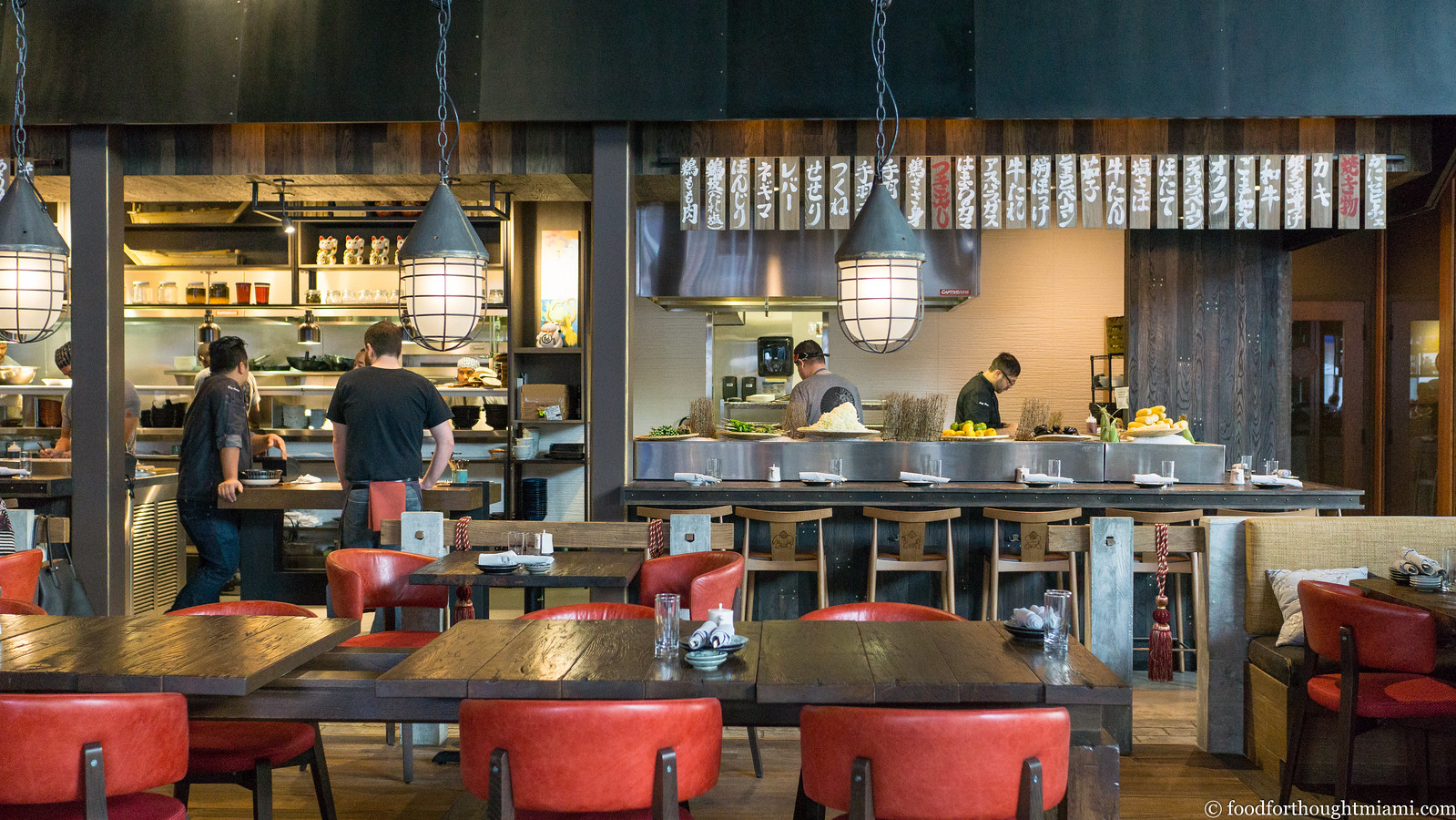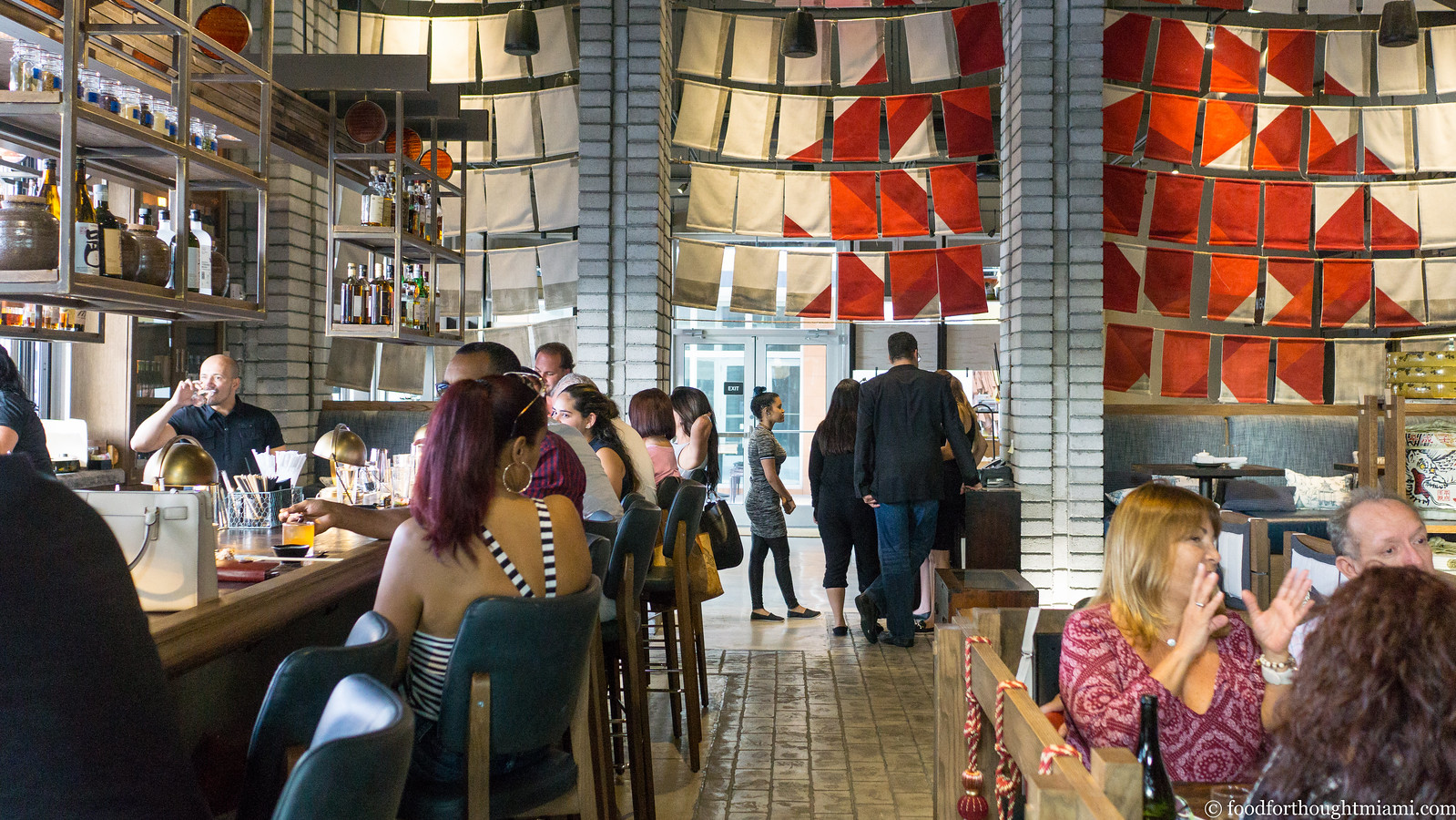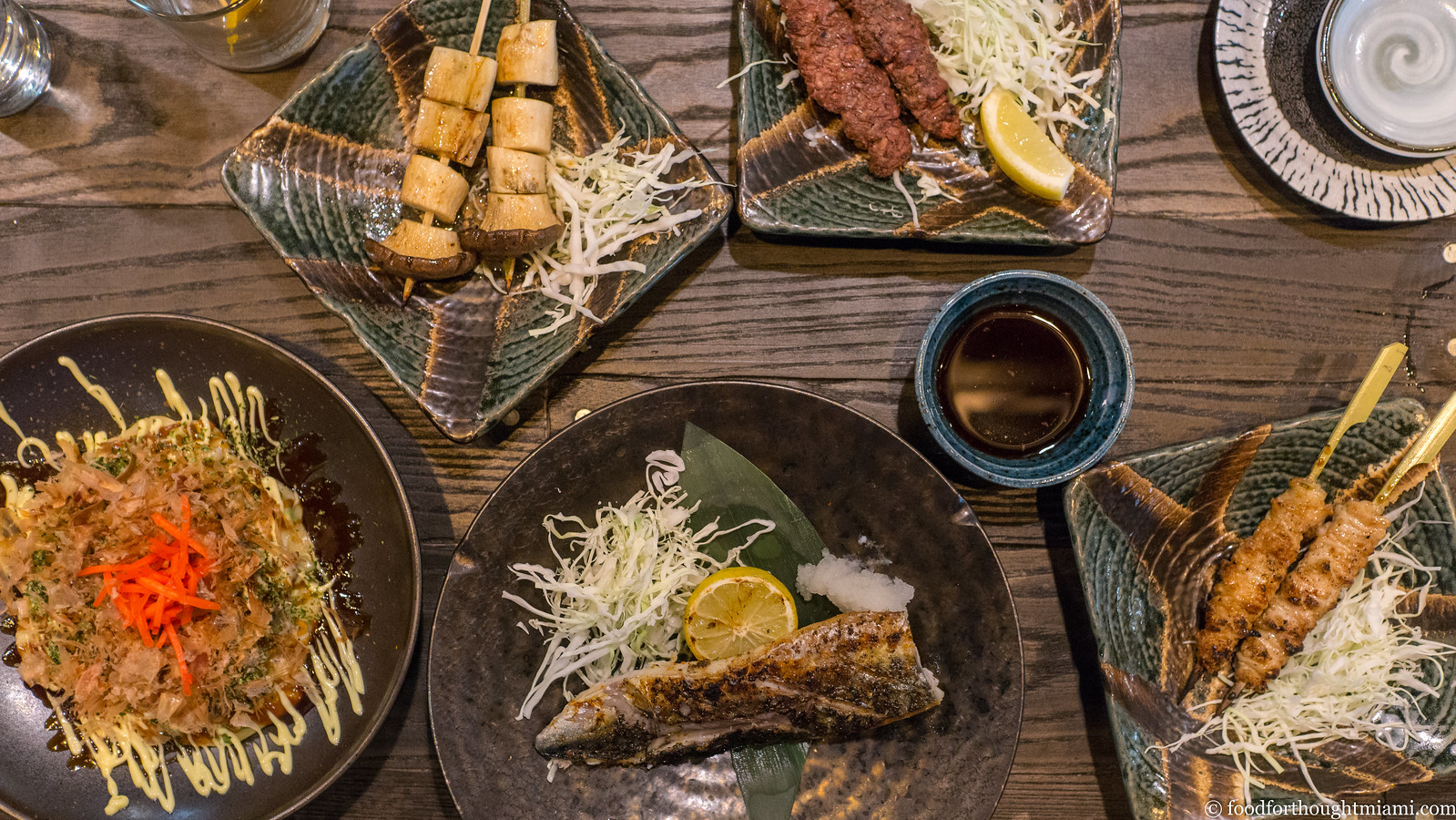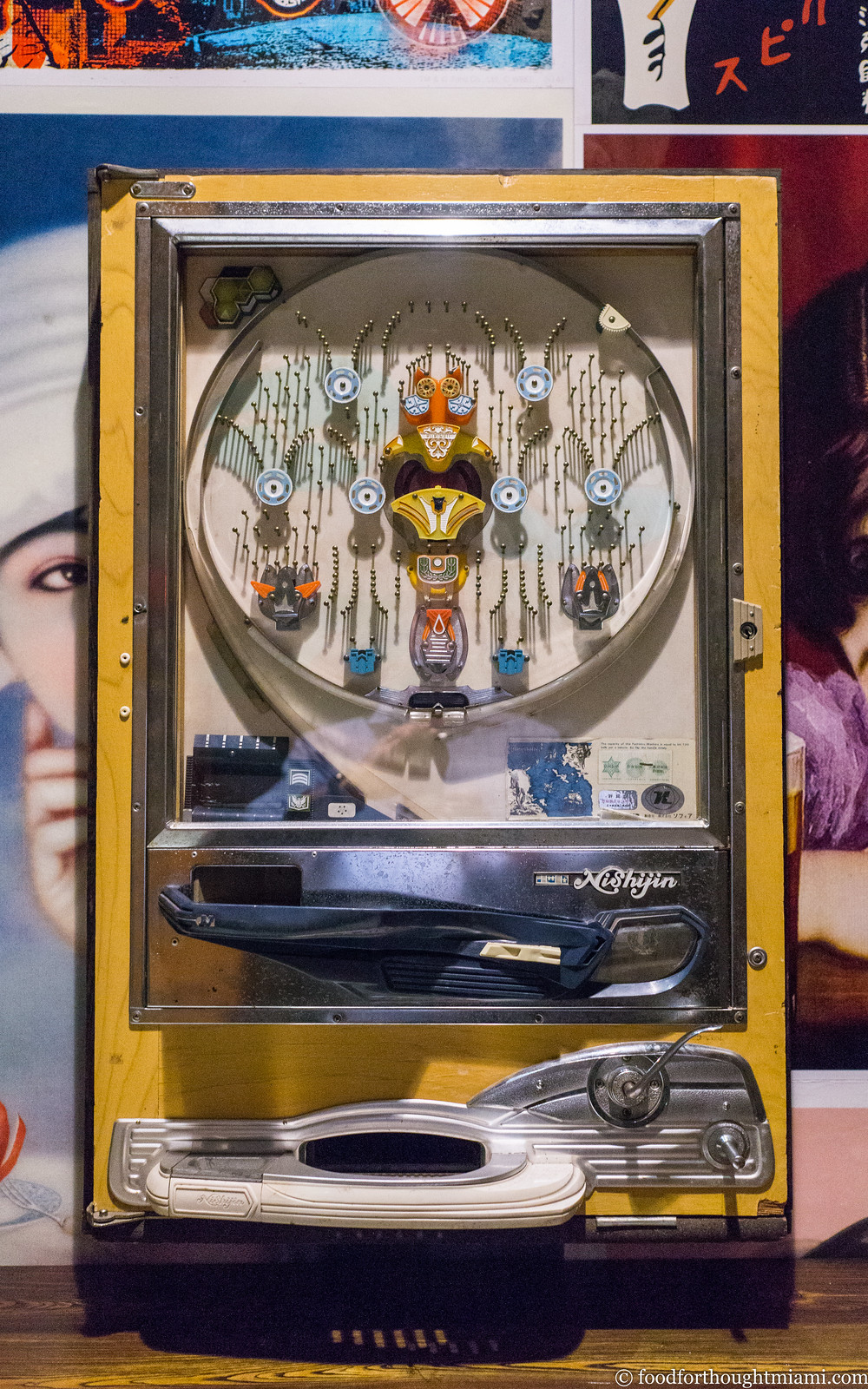Nearly a year ago, I posted some thoughts prompted by an Eater "Future Week" feature on the future of Miami dining. One of the things I predicted was that we would start seeing more independent restaurants in less trendy neighborhoods: places like Doral and Kendall, with lower rents, lots of potential customers, and not much competition other than chains. I'll confess that as a Miami Beach resident, I don't get out that way very often (honestly, I'd usually rather chew off one of my own limbs than drive on SR-836 West). But I braved the westward traffic last week to pay a visit to Dragonfly Izakaya, which opened last month.[1] The menu, which promised seafood from Tsukiji Market and robata-grilled "neck to tail" yakitori, had lots of the right words on it.
(You can see all my pictures in this Dragonfly Izakaya and Fish Market flickr set.)
It's a big venue, with a long and busy indoor/outdoor bar, seating for probably about 100, and an open kitchen with a robata grill and sushi bar. At the entrance is a small space that's slated for use as a fish market, though it's not yet up and running. Dragonfly's a good-looking room, which incorporates Japanese elements into the design – big sake barrels, wooden planks over the robata grill with the menu written in kanji – but not in a completely over-the-top Epcot kind of way.
We started at the bar, which during happy hour features $7 cocktails (including a nice pre-batched Old Fashioned) and several sub-$10 snacks, including a solid rendition of chicken karaage for $5 (that's not the entire portion – someone ate half of it before I got there). After the happy hour clock wound down, we shifted our way over to the sushi bar to sample through the rest of the menu.
We started with a round from the robata grill. The selection was not as broad as the menu promised: a "Neck-to-Tail Tasting Menu" listed several of the more exotic chicken bits, but some of my favorites were not yet available: bonjiri (chicken butt, from the end of the tailbone), seseri (neck, with lots of nice crispy skin) and tsukune (ground chicken meatballs, not sure why these would be so difficult to drum up). But we still did OK – pictured here and working clockwise from top left, eryngii (king oyster mushrooms) doused with butter and lemon, reba (chicken liver) swiped with tare, kawa (crisp, fatty chicken skin), and shio saba (salted mackerel). In the bottom left corner is one of my favorites, okonomiyaki, a sort of savory Japanese pancake studded with cabbage and seafood, then bedecked with Kewpie mayo, okonomi sauce, aonori, beni shoga (red pickled ginger), and wispy bonito flakes. Off-screen: tontoro, grilled pork cheek, served with a nutty sesame oil dipping sauce.
Of these, the highlights were the saba – it was powerfully salty, but the mackerel was tender, oily and fishy in a welcome way – and the okonimiyaki, a treat that's difficult to find here in Miami. The chicken items were good, but lacked that fantastic balance of juicy and crisp that I've experienced at yakitoris in Japan (though that's setting the bar pretty high).
We followed with a round of nigiri: here, from back to front and left to right, hamachi (yellowtail), saba (mackerel), hotate (scallop), ika (squid), ikura (salmon roe), and mirugai (geoduck). Off-screen: ama ebi (sweet shrimp), served in the customary fashion accompanied by their fried heads. Again, the offerings on hand were a bit shy of what was listed on the menu: no o-toro, uni or aji. no kinmedai or aji from Tsukiji market. But from what we sampled, the fish was of pretty good quality – I especially enjoyed the firm snap of the mirugai. The rice was a bit cold, stiff and underseasoned for my taste. The chef also sent over a tuna kobashi for us to sample, with ruby-hued cubes of fish given a riveting dash of kimchi spice and a savory hit of toasted sesame oil, served with slivered avocado and airy rice crackers for some DIY Japanese nachos.
(continued ...)
In addition to the cocktails (many of which feature shochu or sake as well as western spirits), there is a good selection of sakes, almost all available either by the carafe or full bottle (and a few in massive 1.8L bottles). We chose the Zen Tokubetsu, a junmai which I enjoyed quite a bit. I appreciated that they observed the custom of letting the diners choose their own sake cups, and also suggested we follow the custom of always filling each others' cup.
Dragonfly has only been open about a month, and so I can't really quibble over the abbreviated menu. My hope, though, is that they don't give up on the more exotic fish and yakitori items – though it's easy to see how that could happen when the busiest part of the kitchen seemed to be the station churning out makisushi, most of it of the crowd-pleasing variety laden with multiple kinds of fish and even more sauces. I understand doing what you have to keep the seats filled – and for all I know those sushi rolls may be good (I'm not too proud to pass up a pork belly and clam roll at Pubbelly Sushi now and then). But there's much more interesting stuff on this menu if they can get around to executing it in its entirety.
So would I schlep out to Doral again just to go here? Honestly, probably not. But if I were anywhere near the neighborhood, I'd be finding an excuse to come by Dragonfly, and if anyone was looking for recommendations in Doral, I wouldn't hesitate to suggest it.
Dragonfly Izakaya
5241 NW 87th Avenue, Doral, Florida
305.222.7447
[1] A visit to the Downtown Doral development where Dragonfly is located would appear to verify my thesis: right across the street is Bulla Gastrobar, a sibling to the Coral Gables tapas bar, which was packed at 6pm on a weekday. Bulla's Peruvian cousin, Pisco y Nazca, is due to open shortly right down the block, after opening a first location in Kendall earlier this year. And the Dragonfly folks seem to be targeting under-served markets: they opened their first location in Gainesville, then a second in Orlando before opening in Doral.







No comments:
Post a Comment